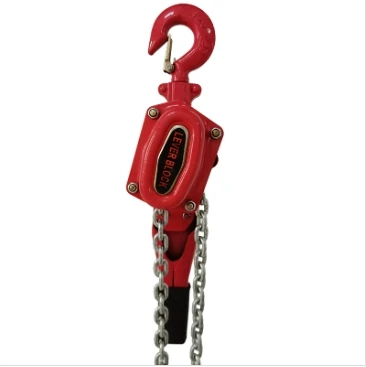


Understanding Lever Blocks A Comprehensive Guide
Lever blocks, also known as lever hoists, are essential tools used across various industries for lifting and pulling heavy loads. Their design allows for mechanical advantage, enabling users to lift significant weights with reduced effort. In this article, we will explore the components, functionality, applications, and safety considerations of lever blocks.
What is a Lever Block?
A lever block is a portable hoisting device that consists of a chain mechanism, a lever arm, and a hook. The lever arm is pivotal in the lifting process, allowing the user to exert force to lift heavy objects. Lever blocks can lift loads ranging from a few hundred kilograms to several tons, making them versatile for different applications.
How Does it Work?
The operation of a lever block is relatively straightforward. The user pulls down on the lever arm, which rotates around a pivot point, thus engaging a chain. As the lever is pulled down, the chain wraps around a drum, effectively raising the load attached to its hook. The mechanical advantage provided by the lever arm allows the user to lift heavier loads than would be possible with manual effort alone.
Key Components
1. Lever Arm The long handle that is used to operate the block. Its length determines the amount of mechanical advantage. 2. Load Chain A heavy-duty chain that is used to lift the load. It is wound around a gear to facilitate lifting. 3. Hook The component that attaches to the load. Most lever blocks feature safety hooks to prevent accidental disengagement. 4. Ratchet Mechanism This allows the load to be held in place without continuous effort from the user, preventing it from falling back down.

Applications of Lever Blocks
Lever blocks are utilized in various fields due to their portability and effectiveness. Here are some common applications
- Construction Lever blocks are used to lift heavy materials, such as beams and concrete blocks, during construction. - Manufacturing In factories, they assist in the movement of heavy machinery and equipment. - Maintenance Lever hoists are essential for effective maintenance in industries where heavy items need to be lifted or moved, such as automotive and aerospace. - Marine and Shipping They are often used to hoist and secure cargo loads in ships and ports.
Safety Considerations
When using lever blocks, safety should always be a priority. Here are some essential safety tips
- Load Limits Always adhere to the manufacturer's guidelines regarding load limits. Overloading a lever block can lead to failure and accidents. - Inspection Regularly inspect the lever block for wear and tear. Check for damaged chains, hooks, or the lever mechanism. - Proper Setup Ensure that the block is set up properly before use. The load should always be secure, and the environment should be clear of obstructions. - Training It is crucial that all operators are adequately trained on how to use lever blocks to minimize the risk of accidents. Proper knowledge in using the device can prevent injuries and equipment damage.
Conclusion
Lever blocks are invaluable tools that simplify the lifting and maneuvering of heavy loads in various sectors. Understanding their operation, components, and safety measures is essential for safe and efficient use. Whether in construction, manufacturing, or maintenance, the lever block remains a reliable choice for professionals looking to enhance productivity while ensuring the safety of their workforce. As technology evolves, lever blocks may continue to integrate advanced materials and mechanisms, further improving their efficiency and user safety in the years to come.



